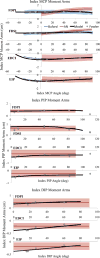Incorporating the length-dependent passive-force generating muscle properties of the extrinsic finger muscles into a wrist and finger biomechanical musculoskeletal model
- PMID: 28774467
- PMCID: PMC5597339
- DOI: 10.1016/j.jbiomech.2017.06.026
Incorporating the length-dependent passive-force generating muscle properties of the extrinsic finger muscles into a wrist and finger biomechanical musculoskeletal model
Abstract
Dynamic movement trajectories of low mass systems have been shown to be predominantly influenced by passive viscoelastic joint forces and torques compared to momentum and inertia. The hand is comprised of 27smallmass segments. Because of the influence of the extrinsic finger muscles, the passive torques about each finger joint become a complex function dependent on the posture of multiple joints of the distal upper limb. However, biomechanical models implemented for the dynamic simulation of hand movements generally don't extend proximally to include the wrist and distal upper limb. Thus, they cannot accurately represent these complex passive torques. The purpose of this short communication is to both describe a method to incorporate the length-dependent passive properties of the extrinsic index finger muscles into a biomechanical model of the upper limb and to demonstrate their influence on combined movement of the wrist and fingers. Leveraging a unique set of experimental data, that describes the net passive torque contributed by the extrinsic finger muscles about the metacarpophalangeal joint of the index finger as a function of both metacarpophalangeal and wrist postures, we simulated the length-dependent passive properties of the extrinsic finger muscles. Dynamic forward simulations demonstrate that a model including these properties passively exhibits coordinated movement between the wrist and finger joints, mimicking tenodesis, a behavior that is absent when the length-dependent properties are removed. This work emphasizes the importance of incorporating the length-dependent properties of the extrinsic finger muscles into biomechanical models to study healthy and impaired hand movements.
Keywords: Extrinsic finger muscles; Finger; Hand; Musculoskeletal modeling; Passive torque; Wrist.
Published by Elsevier Ltd.
Conflict of interest statement
None
Figures



Similar articles
-
Contribution of the extrinsic and intrinsic hand muscles to the moments in finger joints.Clin Biomech (Bristol). 2000 Mar;15(3):203-11. doi: 10.1016/s0268-0033(99)00058-3. Clin Biomech (Bristol). 2000. PMID: 10656982
-
Extrinsic flexor muscles generate concurrent flexion of all three finger joints.J Biomech. 2002 Dec;35(12):1581-9. doi: 10.1016/s0021-9290(02)00229-4. J Biomech. 2002. PMID: 12445611
-
Activation of intrinsic and extrinsic finger muscles in relation to the fingertip force vector.Exp Brain Res. 2002 Sep;146(2):197-204. doi: 10.1007/s00221-002-1177-7. Epub 2002 Jul 18. Exp Brain Res. 2002. PMID: 12195521
-
Extensor physiology in the hand and wrist.Hand Clin. 1995 Aug;11(3):367-71. Hand Clin. 1995. PMID: 7559815 Review.
-
[Paralysis of the intrinsic muscles of the hand].Chir Main. 2008 Feb;27(1):1-11. doi: 10.1016/j.main.2008.02.001. Epub 2008 Feb 12. Chir Main. 2008. PMID: 18325812 Review. French.
Cited by
-
Simulating finger-tip force using two common contact models: Hunt-Crossley and elastic foundation.J Biomech. 2021 Apr 15;119:110334. doi: 10.1016/j.jbiomech.2021.110334. Epub 2021 Feb 23. J Biomech. 2021. PMID: 33662749 Free PMC article.
-
The Biomechanical Basis of the Claw Finger Deformity: A Computational Simulation Study.J Hand Surg Am. 2019 Sep;44(9):751-761. doi: 10.1016/j.jhsa.2019.05.007. Epub 2019 Jun 24. J Hand Surg Am. 2019. PMID: 31248678 Free PMC article.
-
Passive muscle forces in Drosophila are large but insufficient to support a fly's weight.bioRxiv [Preprint]. 2025 Aug 2:2025.04.29.651225. doi: 10.1101/2025.04.29.651225. bioRxiv. 2025. PMID: 40766569 Free PMC article. Preprint.
-
A Musculoskeletal Model of the Hand and Wrist Capable of Simulating Functional Tasks.IEEE Trans Biomed Eng. 2023 May;70(5):1424-1435. doi: 10.1109/TBME.2022.3217722. Epub 2023 Apr 20. IEEE Trans Biomed Eng. 2023. PMID: 36301780 Free PMC article.
-
Cosimulation of the index finger extensor apparatus with finite element and musculoskeletal models.J Biomech. 2023 Aug;157:111725. doi: 10.1016/j.jbiomech.2023.111725. Epub 2023 Jul 13. J Biomech. 2023. PMID: 37459752 Free PMC article.
References
-
- Adamczyk MM, Crago PE. Simulated feedforward neural network coordination of hand grasp and wrist angle in a neuroprosthesis. Ieee T Rehabil Eng. 2000;8:297–304. - PubMed
-
- Babikian S, Valero-Cuevas FJ, Kanso E. Slow Movements of Bio-Inspired Limbs. J Nonlinear Sci. 2016;26:1293–1309.
MeSH terms
Grants and funding
LinkOut - more resources
Full Text Sources
Other Literature Sources

